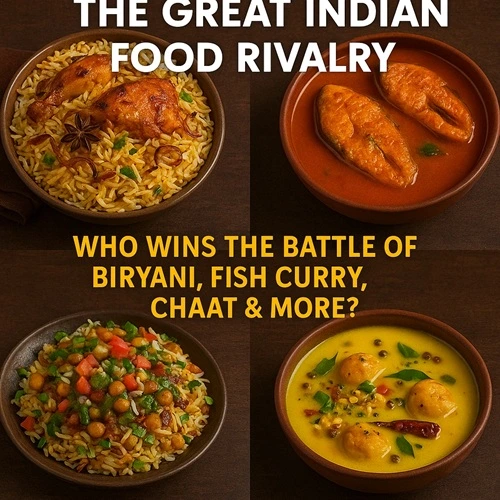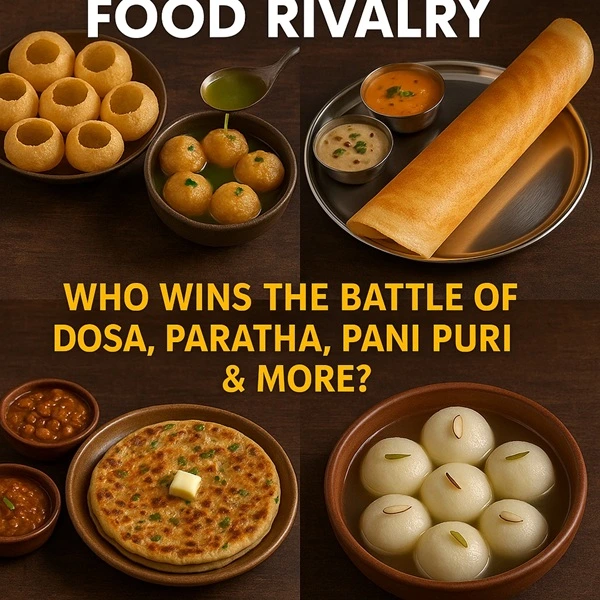When Breakfast and Comfort Foods Turn Into Cultural Showdowns
India’s culinary map is not just a recipe book, it’s a battlefield. A delicious, deeply emotional battlefield. From the sizzling griddle of Amritsar’s paratha stalls to the banana leaf breakfasts of Tamil Nadu, food is a badge of honor, a cultural identity, and sometimes, a reason to argue. Some dishes are so beloved that entire states stake their pride on them. So today, we dive into most mouthwatering Indian food rivalries from across India. Ready to pick a side?

1. Paratha Paradise: Amritsari Stuffed vs Delhi’s Street-Style Crunch
Amritsar: The Ghee Soaked Legend
Thick, lovingly stuffed, crisp on the outside, yet soft inside Amritsari parathas are a full meal. Stuffed with everything from potatoes to paneer, onions to radish, and always slathered with homemade white butter or ghee, these are breakfast royalty. Served with chole, tangy chutney, and dahi, they’re deeply satisfying.
Why it’s legendary:
- Cooked in tandoors or on heavy iron tawas
- Stuffing is mixed with masalas and kneaded into the dough
- Butter is non-negotiable
Delhi: The Fast, Crispy Contender
In contrast, Delhi’s street style parathas, especially from the iconic Paranthe Wali Gali in Chandni Chowk are thinner, crispier, and often deep fried. The fillings can be quirky (banana, khoya, even rabri!), and you eat them with spicy pickle, chutney, and saunf flavored lassi.
Why Delhi wins hearts:
- Fusion style fillings
- More street smart than rustic
- Great for quick bites
Verdict?
Depends on your mood. Amritsar for indulgence, Delhi for variety and adventure.
2. Dosa Debate: Karnataka’s Masala Dosa vs Tamil Nadu’s Paper Dosa
Karnataka: The Golden Brown Masala Dosa
Bengaluru’s masala dosa is thick, crisp yet spongy, with a hidden treasure of spicy mashed potato tucked inside. Often smeared with red chutney and served with coconut chutney and sambar, it’s a wholesome meal.
Why it’s iconic:
- Slightly fermented for a deeper tang
- Uses ghee or butter for richness
- Often roasted to golden perfection
Tamil Nadu: The Crisp Paper Dosa
Then there’s Tamil Nadu’s paper dosa as thin as a sheet, crackling crisp, often spilling off the plate. It’s not about the filling, but the dosa itself the technique, the finesse, the perfect fold.
Why it wins love:
- Precision and minimalism
- Best paired with tangy tomato chutney or gunpowder
- A dosa that’s more craft than carb
Verdict?
Masala dosa fills your belly. Paper dosa feeds your inner perfectionist.
3. Fish Curry Face-Off: Bengal’s Mustard Hilsa vs Kerala’s Meen Moilee
Bengal: The Hilsa in Shorshe Jhol
For Bengalis, Ilish (Hilsa) is not just a fish, it’s a love story. Cooked in a pungent mustard seed paste with mustard oil, green chilies, and turmeric, Shorshe Ilish is sharp, delicate, and deeply nostalgic. Traditionally paired with steaming rice during monsoon feasts.
Why it’s revered:
- Hilsa is a seasonal, prized delicacy
- Mustard oil and green chili provide that addictive kick
- Evokes emotion like few dishes can
Kerala: The Coconut Creamy Meen Moilee
Down south, Kerala’s Meen Moilee is a soothing symphony. Fresh seer fish or pearl spot is simmered in coconut milk, turmeric, curry leaves, and green chilies. Subtle, sweet, and aromatic, it’s best eaten with appams or Kerala red rice.
Why it’s unforgettable:
- A balance of health and indulgence
- Simple ingredients, maximum soul
- Less oil, more flavor harmony
Verdict?
Bengal’s version hits you like a poem; Kerala’s wraps you in a hug. Choose your comfort zone.
4. Chaat Challenge: Banaras vs Lucknow
Banaras: The Wild Child of Chaat
Street food in Banaras is as colorful as its ghats. From Tamatar chaat to Dahi Golgappe, it’s tangy, spicy, and often slightly chaotic but in the best way. Vendors mix flavors with instinct, often chanting their own jingles as they serve.
Why it’s beloved:
- Quirky and experimental
- Everything is chatpata
- Home to unique inventions like palak chaat and banana tikki
Lucknow: The Refined Nawabi Bite
Lucknow’s chaat is more balanced, polished, and elegant. Aloo Tikki, Papdi Chaat, and Basket Chaat are crowd favorites. Everything is portioned, perfectly plated, and made to please the senses.
Why it’s royal:
- More technique, less chaos
- Flavors don’t clash they dance
- Often served in aesthetically pleasing ways
Verdict?
Banaras hits your tongue like Holi. Lucknow is a Mughal miniature painting on your plate.
5. Kadhi Clash: Rajasthani Kadhi vs Punjabi Pakoda Kadhi
Rajasthan: Tangy, Fiery, and Thin
Rajasthani kadhi is light, tangy, and often spicy made without pakodas. It’s more of a soupy side, paired with bajra roti or steamed rice. Often enjoyed during summers, thanks to its cooling effect.
Why it’s distinct:
- Uses dry spices and curd
- Thinner than its Punjabi cousin
- Easy on digestion, high on flavor
Punjab: Hearty, Creamy, and Full of Pakoras
Punjabi kadhi is all about comfort. Made with sour curd and besan, it’s thick and indulgent, loaded with onion pakoras. It simmers for hours and is served piping hot with jeera rice or tandoori roti.
Why it’s a crowd-pleaser:
- Deep comfort food
- Pakoras make it filling and rich
- Great for winter or rainy days
Verdict?
Rajasthani kadhi is summer poetry. Punjabi kadhi is a warm blanket on a cold night.
6. Biryani War: Hyderabad vs Lucknow vs Kolkata
Hyderabad – The Dum Biryani Royal
Born in the kitchens of the Nizams, Hyderabadi biryani is the quintessential dum style, raw meat marinated, layered with basmati rice, sealed with dough, and slow cooked to aromatic perfection. Legend attributes its creation to the first Nizam’s chef during the 18th century, fusing Mughal and Deccani traditions.
Lucknow – The Elegant Dum Pukht
In contrast, Lucknow’s Awadhi biryani is part of a royal cuisine shaped by the city’s famed dum pukht technique, slow cooking in sealed pots with nuanced spice layering.
Lucknow is on track to be recognized as a UNESCO City of Gastronomy, highlighting dishes like Tunday kebabs, nihari, and its signature biryani, a testament to its layered elegance and culinary storytelling.
Kolkata – The Comfort & Cost Coup
Though not always front and center in biryani debates, Kolkata’s biryani variant deserves a shoutout for its uniquely affordable style featuring potatoes and a subtly flavored rice meat combination, a comfort classic across India, often underrated when fuel costs matter most.
7. Street Snack Showdown: Puchka vs Pani Puri
Kolkata – Puchka: Sharp, Tangy, Precise
In Kolkata, puchka is a bold experience, thin whole wheat puris that crackle, mashed potato filling spiced with tamarind and hing, and intense tamarind chilied pani that wakes up your palate. Each puchka is served fresh, often one by one, turning the snack into a ritual.
Mumbai – Pani Puri: Sweet, Earthy, Fast
Mumbai’s pani puri reveals a contrasting personality semolina puris, ragda or potato filling, and milder tamarind jaggery water that’s sweeter and crowd friendly. Served quickly and often in bulk, it matches the city’s fast paced rhythm.
Regional Reflections
- Kolkata’s bold spice reflects its love for intense flavors and slow savoring.
- Mumbai’s sweeter, faster version mirrors its multicultural hustle and sweet‑sour balance.
8. Sweet Controversy: Rosogolla vs Rasagola
West Bengal – Banglar Rosogolla: Spongy & Official
West Bengal clinched the GI tag for “Banglar Rosogolla”, anchoring its claim with documentation of innovation by sweet maker Nabin Chandra Das in Bagbazar circa 1868 producing the first spongy, soft rosogolla in light sugar syrup.
Odisha – Rasagola: Ancient Ritual Claim
Odisha maintains that its Pahala rasagola was offered as bhog to Goddess Lakshmi at Puri’s Jagannath Temple since the 12th century. Although Odisha applied later for a GI tag, the night was already won by Bengal, leading to ongoing debates.
Dual Identity?
While Bengal’s GI is focused on its unique recipe process, Odisha claims religious and historical precedence, a beautiful case of shared heritage with contested ownership.
Final Verdict: There’s No One Winner—Only Diverse Deliciousness
Trying to pick the “best” dish in an Indian food rivalry is like trying to choose your favorite child. Impossible and slightly unfair.
Each dish from Amritsari paratha to Tamil Nadu’s paper dosa, from Bengal’s hilsa curry to Kerala’s meen moilee is not just food. It’s emotion. It’s a story on a plate. It reflects local culture, geography, climate, history, and community pride.
These food rivalries don’t divide us they enrich us.
So instead of asking “Which one is best?”, maybe the better question is:
“Which one will I try next?”
FAQ: Indian Food Rivalries
1. What is the most famous Indian food rivalry?
The most well known Indian food rivalry is between Hyderabadi Biryani vs Lucknowi Biryani both claiming royal roots and unique cooking styles. It’s the ultimate north vs south biryani war.
2. Which Indian state has the best parathas?
Punjab (Amritsar) is renowned for thick, ghee laden, stuffed parathas, but Delhi’s Paranthe Wali Gali offers quirky and flavorful varieties that make it a close rival.
3. What’s the main difference between Karnataka’s masala dosa and Tamil Nadu’s paper dosa?
Karnataka’s masala dosa is thicker, spongier, and filled with spicy potato mash, while Tamil Nadu’s paper dosa is crispy, paper-thin, and usually served plain with chutneys.
4. Why do Bengal and Odisha both claim the origin of rosogolla?
Bengal credits Nabin Chandra Das for inventing the spongy rosogolla in 1868, while Odisha claims religious and cultural precedence dating back to the Jagannath Temple traditions. Both have valid claims and both now hold GI tags for different versions.
5. Is food rivalry just about taste?
No. Indian food rivalries are about heritage, identity, community, pride, and nostalgia. The flavors are part of the story, but the emotional connection is what makes them so powerful.
For more such interesting Food Updates , Follow Popnewsblend.com.

Hi, I’m Prashant Jain — a curious soul, storyteller, and content creator at heart.I’ve always been drawn to the world of entertainment, travel, sports, health & lifestyle — not just as a writer, but as someone who genuinely lives these experiences. Whether I’m binge-watching the latest OTT series, exploring offbeat spiritual destinations in India, or diving deep into wellness routines and cricket match insights, I love sharing what I discover with like-minded readers.
PopNewsBlend is my way of blending personal journeys with meaningful stories — ones that inform, inspire, and keep you ahead of the curve. Everything I write comes from real observations, hands-on experiences, and a deep passion for understanding the world around us.
Discover more from Popnewsblend
Subscribe to get the latest posts sent to your email.







